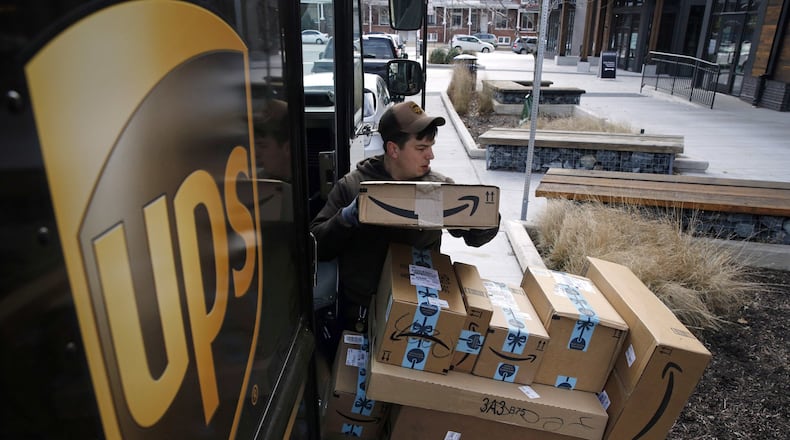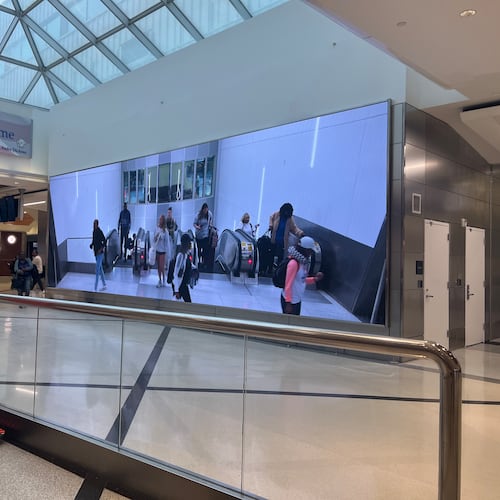UPS, FedEx, the U.S. Postal Service and other carriers pressed through a record crush of holiday shipments to deliver most packages in time for Christmas — but more than 2 million parcels did not arrive before the big day, according to new data.
Logistics data firm ShipMatrix said the on-time delivery rate for UPS was 97.6% for packages scheduled for delivery between Dec. 20 and 26, while FedEx came in at 96.5% and the Postal Service at 94.7%.
Because of the huge volumes of packages being moved, even those small percentages of delayed deliveries can affect millions of packages.
It’s still better than many feared during a peak period that had unprecedented holiday season demand piled on top of pandemic home deliveries and urgent vaccine shipments. Shipping firms delivered more than 3 billion packages throughout the full peak holiday period, which typically starts the day after Thanksgiving.
But some deliveries were made on Christmas Day, and hundreds of thousands of packages were delayed by several days, according to ShipMatrix president Satish Jindel. He expects that will result in more return shipments.
UPS said in a written statement that it “delivered one of the best peak seasons ever for our customers,” due to preparation, coordination with retailers and employees, and the use of technology.
Sandy Springs-based UPS did not share delivery performance data, but it referenced ShipMatrix’s industry estimates.
Industry observers have warned for months that parcel delivery firms could become overloaded during the holiday season and urged people to order early in order to get items in time. Longer delivery times persisted through much of the year — and UPS and FedEx have both waived on-time service money-back guarantees due to the pandemic.
The U.S. Postal Service has an alert on its website warning that it is “experiencing unprecedented volume increases and limited employee availability due to the impacts of COVID-19.” The postal service’s on-time delivery performance earlier in 2020 declined significantly compared with 2019, according to quarterly data. Delivery delays have also raised concerns for mail-in ballots.
Jindel said before Christmas that consumers had heeded advice about delays, resulting in lower online order volume to help with on-time delivery performance. On-time delivery rates improved in Christmas week compared with the week before.
One factor that helped UPS and FedEx keep shipments moving was refusing to take excess packages, forcing retailers to find alternatives such as the Postal Service. The Postal Service had to handle an extra few million parcels a day not accepted by UPS and FedEx, according to Jindel.
UPS chief sales and solutions officer Kate Gutmann said before the wave of online holiday orders hit, the company went into more in-depth discussions with retail executives than in years past.
“We actually determined collectively — both us and they — how many orders they would release from each of their distribution centers by day,” Gutmann said. So for Cyber Week, the big online shopping period that follows Thanksgiving, “We had a certain limit.”
“That amount was reached,” Gutmann said. “We then mutually agreed that the next packages, the next loads, would feather in the following two days. And that was all by plan.”
Competitor FedEx took a similar approach. Overall, peak period on-time performance was up slightly for UPS and FedEx compared with 2019, according to ShipMatrix. But by rejecting packages, the two private carriers further strained the Postal Service.
“I’ve never seen capacity controlled as tightly as it has been this peak season,” said John Haber, CEO of Atlanta-based supply chain consulting firm Spend Management Experts. He added that since UPS CEO Carol Tomé took the helm at the shipping giant last year, there’s “a different philosophy with the new regime.”
Tomé, a former chief financial officer at Home Depot, has emphasized that “bigger is not necessarily better... (so) they’re not going to build out tons of capacity and then try to fill it out by offering very aggressive pricing,” Haber said.
About the Author
The Latest
Featured


